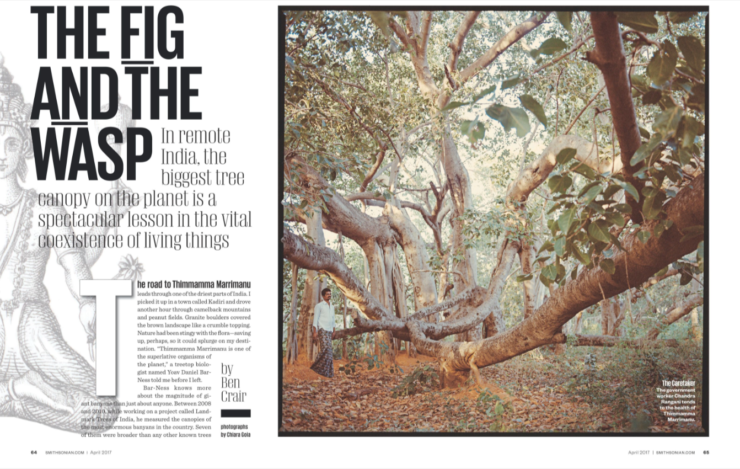
The finished spread in Smithsonian Magazine.
As a senior editor commissioning science features for Smithsonian Magazine, Jennie Rothenberg Gritz gets tons of freelance queries. Yet few cold pitches result in an article. Why not?
“They’re often stories that should be told, but they’re not being framed as good stories, with good characters, narrative and a little twist that makes you surprised,” she says.
That doesn’t mean Gritz isn’t looking for new writers with great ideas. The science stories she runs generally overlap with the themes of the Smithsonian Institution’s collections, including animals, the environment, space and human health. Contrary to what some writers assume, however, only the front-of-book section and certain themed issues require stories with a historical element.
I talked to Gritz, who previously edited web features for The Atlantic, about her pitching preferences and pet peeves. We also annotated a cold pitch she got from journalist Ben Crair that ended up running in the April 2017 issue; online it was called “The Biggest Tree Canopy on the Planet Stretches Across Nearly Five Acres.” Our conversation has been edited for length and clarity.
What’s the best way for a writer to break into the Smithsonian in print?
All sections are open to freelancers, but shorter pieces are the best way to start for a new writer. Our front-of-book section, called Prologue, recently changed to be all about creative, interesting takes on history. If someone does a 500- to 700-word piece and we really like it, then we’re more likely to accept a feature. It’s not super common to accept a pitch that involves sending a new writer to an exotic location.
What should freelancers keep in mind about your editorial calendar when they’re pitching?
With any magazine that has themed issues, you know they’re going to be thinking at some point in the year about how to fill them. If you look at our past issues online, you can figure out the themes. Every year, we have a package called “Evotourism” about places you can visit that have to do with evolution. We also have a “Future” issue every spring. There’s the “Secrets of American History” issue in the fall. In mid-September, we already have lots of stories slated for the following April.
“You don’t always need to have a character driving the pitch. It could just be an interesting juxtaposition of ideas or a really cool technology.”
How much pre-reporting do you like to see in pitches?
We want to know that the writer knows the subject. We also ask whether there have been other stories about the topic before. If the writer knows who the scientists or figures they’re going to talk to are, that’s really good. If he or she has a specific trip or place in mind, that’s also helpful. We want a story, not a topic: “Here’s a specific thing that’s happening, and I can tell you about it.” We have a few columns on science and history that are more personality-driven and essay-like, and some people have sent me fully finished pieces to look at for those.
Generally, around four paragraphs or one page sounds about right for a pitch. Some people really like pitches to be super-short, but I need to see enough to know there’s substance there, especially for a feature.
What sets apart the pitches you say yes to?
There has to be something surprising and narratively interesting there. If the story is about the natural world, either the person you’re writing about has to be super charismatic and interesting, or something done about the issue has to be amazing. Often I get pitches along the lines of: A species of lichen is disappearing, and a scientist is doing research to see why. But lichen isn’t itself interesting, and they’re not doing some wild, crazy thing to deal with the problem. An example of great story my predecessor commissioned and I ended up editing was about a scientist helping to stop the elephant poaching trade by creating a map of Africa based on elephant poop. Poop is super weird and interesting!
You don’t always need to have a character driving the pitch. It could just be an interesting juxtaposition of ideas or a really cool technology. In fact, in some cases it’s a low-hanging fruit to go for stories where a wacky, zany scientist drives a crazy car and wears crazy clothes. Unfortunately, women in science can’t afford to be wacky and zany as much as men and end up being missed. A good writer can just make things interesting.
What are some of your other pet peeves?
I get a lot of pitches that are about something that I’ve seen before. Sometimes I Google the subject and immediately see that someone else has already written the story. I also get put off when a pitch is too earnest: It’s a worthwhile topic, but it’s not interesting or too dry. We get a lot of scientifically minded people who don’t know how to tell a story and make things vivid. Often, I kick a story to my web colleagues, because for them it can be more of a brushstroke of an idea. For print, you need a much more fleshed-out story. If you want to be the kind of writer I would reach out to with an assignment, it doesn’t really work to send an email like, “I write about healthcare in China. Please keep me in mind.” Sending an idea that is novel and colorful is more likely to catch an editor’s attention.
What’s your preference when it comes to writers following up on pitches?
It’s always nice to get the email that says, “I haven’t heard back from you, so is it all right if I send it to other magazines?” It’s true in anything in life: If people are nice, you want to work with them more.
Many writers feel like they’re not always extended the same courtesy from editors. What should writers think when editors don’t respond, even when they follow up?
I think editors are just inundated. When I was in journalism school 15 years ago, we didn’t expect to get responses. It was a really big deal to get any response. Now that there’s email, suddenly we’re expected to write back to every pitch. A lot of pitches don’t get responses, unfortunately. But if there’s a sparkle of something that could work for us, I’ll often push the writer more. Some pitches have worked out through that kind of back and forth.

Pitching longform stories is almost as mystical as the ability to pitch in the big leagues.
And here’s the annotation of the story pitch. My questions are in red, her responses in blue. To read the pitch without annotations first, click the ‘Hide all annotations’ button.
This month I am planning to travel to Bangalore. Is it a good idea to pitch before traveling somewhere, and how far in advance? A month was good. Since he was a new writer for us, it was good that he was going on a trip already paid for by someone else. We were really glad to have the story, but it probably wouldn’t have merited thousands of dollars for a writer we’ve never worked with before. Of course, we still paid the expenses. For writers we trust, or stories we really want from our side, we’ll definitely pay. The Smithsonian actually has a pretty good travel budget. While there, I would like to visit Thimmamma Marrimanu, a fig tree that is the largest tree in the world. It is so large that you can actually miss the tree for the forest. Thimmamma Marrimanu’s branches spread across the ground and rise again toward the sun, giving an impression of many different trees. Its canopy covers more than five acres, offering enough shade for twenty-thousand people. What worked for you about this opening? By the time we get to end of this pretty short paragraph, he’s given us a vision of something. He knew his audience well enough to know that, because of its origin in museums, Smithsonian is a magazine more driven by things than ideas: concrete scenes, objects, discoveries. For us, a tree is really cool. He also used superlatives right away: Magazines generally like things that are the “largest” or “oldest.” We could also tell right away he was a really good writer: We could see the tree, and it was a really captivating image.
“Thimmamma Marrimanu is quite possibly the largest living thing on the planet,” says YD Bar-Ness, a treetop biologist who studied India’s giant banyan trees from 2008 to 2010. What effect did including this quote have? It showed that he’d gone far enough to talk to one of the experts on this topic and that there was a character. In the end, he didn’t end up being featured prominently, but when you’re talking about a tree, it’s nice to see that there are humans there as well. And it gave the pitch authority: A scientist was backing up his assertion that it was the largest tree on the planet. Using simple technologies like Google Maps, Bar-Ness measured eight giant banyans across the subcontinent. Thimmamma Marrimanu was the largest, but all eight trees were bigger, by area covered, than any known tree in another country. And yet India’s giant banyan trees enjoy little of the fame of other superlative trees, like California’s sequoias.
I’d like to write a story for Smithsonian on Thimmamma Marrimanu. The giant banyan began life 600 years ago as a tiny seedling in the branches of another tree. It dropped its roots to the forest floor, slowly enveloped its host (the banyan is what’s known as a “strangler fig”), and spread outward over the centuries. In India, people have assigned it a mythological origin: They say Thimmamma Marrimanu sprang from the spot where a widow threw herself on her husband’s funeral pyre. Young couples visit Thimmamma Marrimanu today for fertility blessings. Another famous giant banyan is said to have grown from the spot where a deity dropped his toothbrush. Why did it help to add this spiritual or cultural element? It’s not common for a science story to have a religious dimension. There are a lot of cool angles in this pitch that harmonize really well.
A banyan need not be giant in order to be holy. Smaller specimens grow all over India—they are “pioneer” plants that thrive in inhospitable places—and they too are often worshiped. In some areas of India, it is taboo to knock them down. As a result, banyans sometimes stand in fields as the only surviving plants from ancient forests, and their figs continue to attract monkeys, birds, and rodents. Human values and the natural world intersect beneath the banyans. They are symbols of what makes India so appealing to the imagination.
On the science side, the world’s broadest trees owe their existence to one of the tiniest insects: the fig wasp. What was the effect of including this detail? It shows that he has a poetic sensibility. You have to be careful with that, because you don’t want to be overwrought and pompous. But you want to show that you have a mind that can take in symbolism and be literary in the pitch. Someone else might’ve missed this point—the smallest insect and biggest tree need each other to survive—but his mind worked in a storytelling way. The relationship between fig plants and fig wasps is probably the best example in nature of “co-dependent evolution”: One without the other would quickly go extinct. The relationship between fig plants and fig wasps is one of evolution’s most poetic products, and Thimmamma Marrimanu would be a good place to study it. Once he got to evolution, I was sold because that’s one topic area where we’re always looking for something. He sent this right at the time I was looking for stories on evolution in places one could travel as a tourist for our “Evotourism” issue, about six months in advance.
Bar-Ness is currently in Tasmania, but has offered to hook me up with the local biologists in Bangalore who know Thimmamma Marrimanu best. I should already have travel to India covered by another assignment, and Thimmamma Marrimanu is just a few hours outside the city, so expenses would be modest. How important is it for the pitch to discuss logistics like this? It helps, especially if someone wants to go to an exotic locale. It’s less important if it’s an armchair or local topic. It made him come across as a real professional who knew the nuts and bolts that would be involved. Is there anything that would’ve made this pitch even better? If he’d said, “I have this in mind for your Evotourism issue,” we would’ve been flattered. Magazines like when people notice they have special issues because they take a lot of work. If we didn’t have that package, I would’ve pushed for more of a news hook. I’ll give a pitch closer attention if it says it’s similar to a certain piece we ran—it shows the person is an actual reader. It’s also helpful to say, “I’ve never seen a story about this in a mainstream magazine” or something similar. Did you have any questions for him, or did you assign it right away? I sent a few questions. I asked where this had been written about before. I also wanted to know a bit more about the fine points of the evolution aspect. And I wanted to know how accessible the place was, since I wanted to make sure it was actually a tourist site. We went on to assign him another story he pitched for the upcoming Future issue, so this pitch brought him into the fold.


